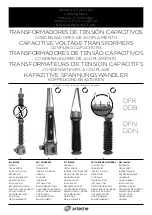
SP3X Sensors
LXT-380 Universal Transmitter
Teledyne Analytical Instruments
62
8.3.3 ELECTRODE CLEANING
An important aspect of sensor maintenance is the service of the
electrode cartridge. After being in operation, an electrode may begin to
exhibit slow response or non-reproducible measurements. This may be
due to coating of the measurement electrode or clogging of the reference
junction. Regular electrode cleaning reduces problems associated with
the coating and clogging. Frequency of cleaning will depend on the
process and application. The following procedures are used to clean pH
and ORP electrodes.
If possible, the electrode should be cleaned without removing it
from the sensor body. However, if the electrode must be removed, the o-
rings must be inspected and re-lubricated. See section 3.10.
8.3.4 PH ELECTRODE CARTRIDGE CLEANING
Remove the sensor from the process and carefully wash the wetted
end of the electrode cartridge in a mild solution of detergent and water
or with methyl alcohol. If the electrode response is not improved, soak
the electrode in 0.1 molar HCl for 5 minutes. Remove and rinse the
electrode with tap water and soak in 0.1 molar NaOH for 5 minutes.
Remove the electrode from the NaOH solution, rinse the electrode
and soak in a 4 pH buffer solution for 10 minutes. This should improve
the response of the electrode. If not, replace the electrode.
If the electrode must be left out of the process for an extended
period of time, store it in a solution of water saturated with KCl or a 4.0
pH buffer solution.
Teledyne does not recommend the storage of
electrodes in distilled or deionized water
.
8.3.5 ORP ELECTRODE CARTRIDGE CLEANING
Cleaning the platinum surface to remove coating can be done using
an abrasive cleaner like 600-800 grit wet/dry sand paper or chemical
reagents specific for the type of coating. Abrasive cleaning is the most
common method of cleaning and is usually sufficient to restore the
platinum surface; however, some processes can form a hard coating
requiring chemical cleaning with a strong acid solution. Acid solutions
greater than 10% are not recommended.
Summary of Contents for LXT-380
Page 2: ......
Page 4: ......
Page 5: ......
Page 6: ......
Page 19: ...LXT 380 Universal Transmitter Teledyne Analytical Instruments xiv Blank Page...
Page 55: ...Operation LXT 380 Universal Transmitter Teledyne Analytical Instruments 36 Blank Page...
Page 69: ...Maintenance LXT 380 Universal Transmitter Teledyne Analytical Instruments 50 Blank Page...
Page 71: ...Troubleshooting LXT 380 Universal Transmitter Teledyne Analytical Instruments 52 Blank Page...
Page 78: ...LXT 380 Universal Transmitter SP3X Sensors Teledyne Analytical Instruments 59...
Page 91: ...Appendix LXT 380 Universal Transmitter Teledyne Analytical Instruments 72 B LXT 380 Hart Menu...
Page 92: ...LXT 380 Universal Transmitter Appendix Teledyne Analytical Instruments 73...
Page 96: ...LXT 380 Universal Transmitter Appendix Teledyne Analytical Instruments 77...
Page 97: ...Appendix LXT 380 Universal Transmitter Teledyne Analytical Instruments 78...
Page 99: ...Appendix LXT 380 Universal Transmitter Teledyne Analytical Instruments 80 Sensor Type...
Page 101: ...Appendix LXT 380 Universal Transmitter Teledyne Analytical Instruments 82 E Drawings...
Page 102: ...LXT 380 Universal Transmitter Appendix Teledyne Analytical Instruments 83...
Page 103: ...Appendix LXT 380 Universal Transmitter Teledyne Analytical Instruments 84...
















































